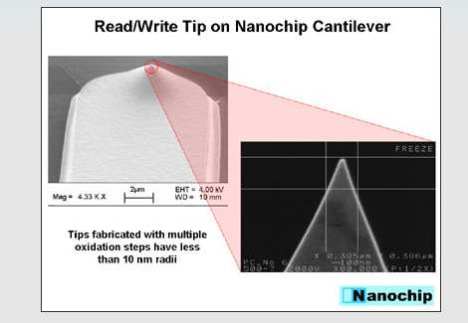Bytes, not bits. Oh, and it’s fast, too.
Nanochip, a Silicon Valley-based fabless semiconductor firm, just received $14 million in funding to complete work on a 100 GB storage chip. Intel Capital, who should know something about chips, is an investor. The goal: “. . . allow Nanochip to complete development of its first prototypes later this year . . . .”
The Nanochip design is a Micro-Electro-Mechanical System, or MEMS, device. A descendent of IBM’s Millipede device, it uses polarization instead of Millepede’s heat to store data. An array of tiny probes - looking like phonograph needles, if any of you have ever seen one - less than 25 um in diameter, changes the state of the recording medium. The probes are movable - similar to the mirrors on DLP chips - so they can write more than one location. Since there are many thousands of probes, they have a lot of bandwidth.
This is persistent storage, i.e. it retains data with the power off. The Millipede design proposed using a heat-sensitive polymer to create little CD-like pits to record data. They couldn’t get that to work so now they are using an electrical method.
Here’s a scanning electron microscope picture of a probe:
The chip is actually 2 chips bonded together. One chip has the array of probes and the other has the media. They are bonded, diced and then mounted in traditional plastic packaging. The really cool thing is that they can use 10 year old, fully depreciated, fab equipment to build these chips. They don’t need deep UV technology or any of the other costly tricks chip makers use today to scrunch chip sizes. A 1 micron fab is fine. That should translate into much lower costs.
The design is scalable to 1 TB chips, according to Nanochip. - zd
The back up Blog of the real Xenophilius Lovegood, a slightly mad scientist.
Friday, April 11, 2008
100 GB memory chip coming in 2009
Subscribe to:
Post Comments (Atom)

No comments:
Post a Comment